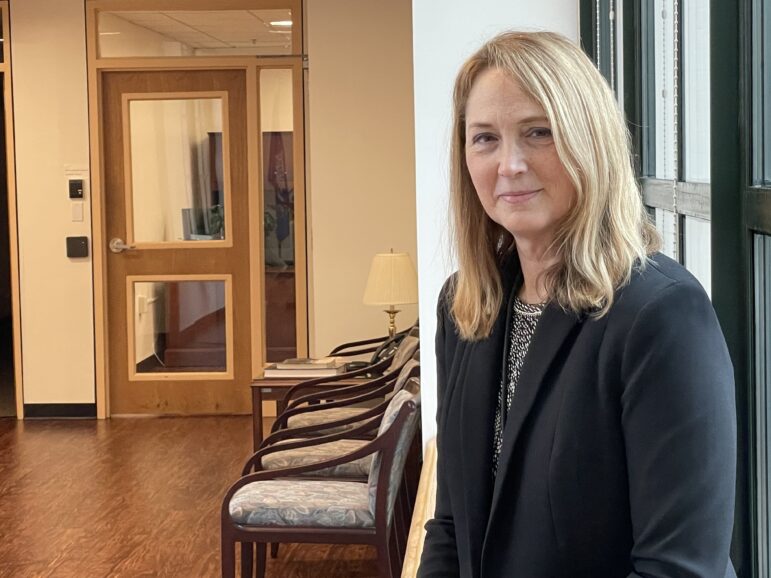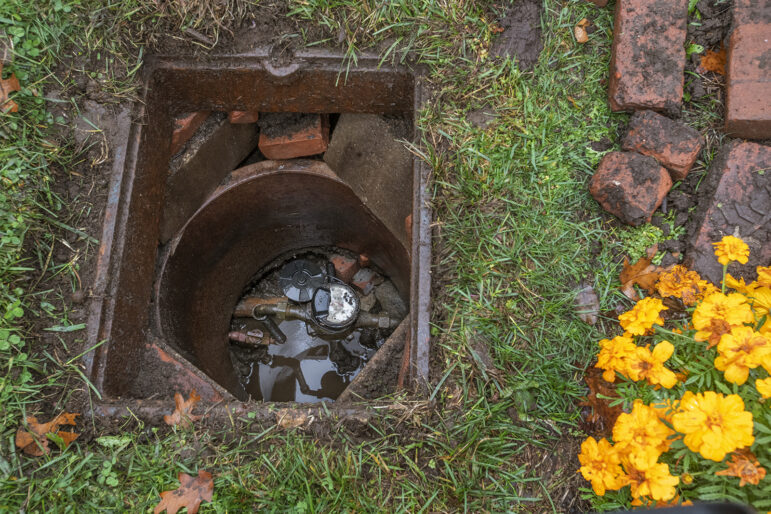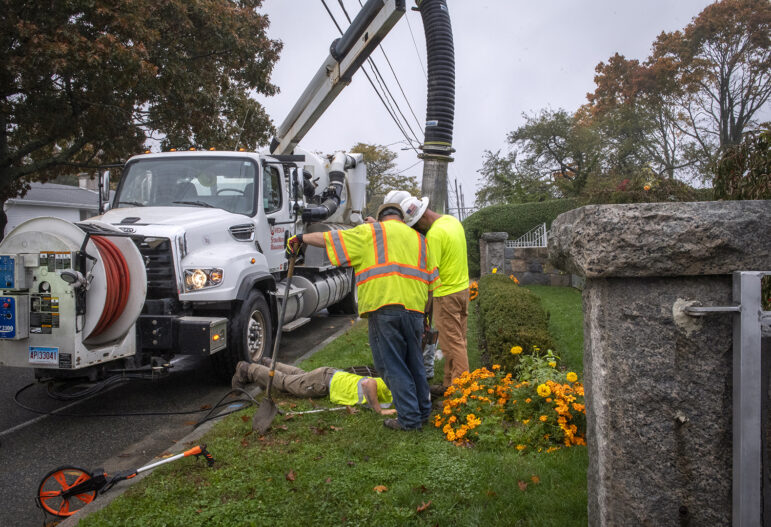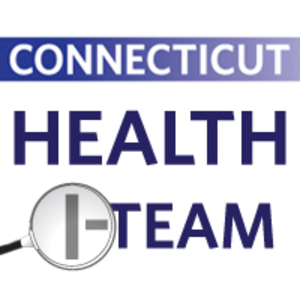By Jenifer Frank
RECOMMEND TWEET EMAIL PRINT MORE

Melanie Stengel Photo.
Joseph Lanzafame, New London’s Public Utilities director, on Pequot Avenue where an exploratory “test pit” was drilled.
As soon as he heard that President Biden’s Bipartisan Infrastructure Act would include more than $4 billion to replace lead water pipes in the country, Joseph Lanzafame, New London’s public utilities director, knew two things:
First, no matter how much money Washington spent on the undertaking, it wouldn’t be enough.
And second, Lanzafame knew he wanted New London to be first on the state’s priority list for funding. “If we get out ahead of it,” he said, “we’re more likely to get additional subsidies … and we’re going to help set the standard for the state.”
Over the past two years, New London has been aggressively inventorying its pipes, the first step in the replacement process. Lanzafame has pored over historical records, hired engineers to do predictive modeling, and arranged for exploratory “test pits” to be drilled throughout the city to determine how many of its public water lines are made of lead.
“We have a significant portion out there,” he said. Last week’s estimate: More than a third of New London’s 6,500 service lines are lead.
‘It’s Historic’
Between 6 million and 10 million lead water pipes are in use today, most frequently in older cities and in homes built before 1986, according to the U.S. Environmental Protection Agency. Lead pipes were used in the decades after the Civil War until the 1940s, and many have never been replaced.
Although lead paint and leaded dust and soil cause most of the lead poisoning cases in the country, especially among babies and young children, 20% of people’s exposure to the highly toxic metal is through drinking water, the EPA says.
Connecticut is slated to receive about $30 million in each of the next five years through the Bipartisan Infrastructure Act to find and replace lead pipes with those made of copper, said Lori Mathieu, public health chief of the Drinking Water Section of the state Department of Public Health.
Although Lanzafame is correct that the federal money won’t cover anywhere near the cost of replacing the pipes, Mathieu is exuberant about the funding. “We’ve never seen this level of money,” she said. “It’s very exciting. It’s historic.”

DPH Photo.
Lori Mathieu, head of DPH’s Drinking Water Section, is overseeing the statewide lead pipe project.
The Inventory
Lead service lines are the pipes that connect homes, apartment buildings and businesses to water mains, which run down the middle of streets. The public side of the service line goes from the water main to a shutoff valve, or curb stop, at the property line, while the customer’s side goes from the shutoff valve to a home or business’s indoor plumbing.
Once test pits are bored at the point where the two sections meet, engineers can determine whether one or both parts of the water service line are made of lead. Engineering companies that specialize in statistically predictive modeling are hired so every water line in a municipality doesn’t have to be dug up. The cost of that would be “astronomical,” even in a small city like New London, said Lanzafame.
As it is, he estimated the total project cost for New London at $40 million over the next five years, though it could be lower with federal grants or principal forgiveness loans.
Social Vulnerability
Problems caused by lead pipes were most recently in the public eye during the 2014 water crisis in Flint, Mich. Officials in the cash-strapped city changed the source of drinking water from Lake Huron, whose water was treated, to the Flint River, whose water was untreated. The corrosive water flowing through lead pipes led to health problems throughout Flint and resulted in thousands of children under 6 registering high lead levels in their blood.
The Infrastructure Act requires “socially vulnerable” areas to be priorities for lead pipe replacement. The government’s Social Vulnerability Index (SVI), developed by the U.S. Centers for Disease Control and Prevention, uses Census data such as socioeconomic level, housing conditions, access to transportation, and racial and ethnic minority status to identify Census tracts that need more resources to thrive.
However, Lanzafame said, “The SVI doesn’t have anything to do with the statistical model. The statistical model doesn’t care about color or race or economic situation, it just says lead line or no lead line.” As it continues to process information about the location of lead service lines, he said, the city will apply the social vulnerability index to the data. “So, people who happen to live in areas that are higher SVI are going to get their lines replaced first,” he said.
Poison In The Home
Unsurprisingly, many areas with high SVI rankings also have large numbers of lead-poisoned children. The CDC stresses that any amount of the heavy metal is unsafe, now defining lead poisoning as 3.5 micrograms per deciliter of lead or more in the bloodstream. Before May 2021, the CDC benchmark for lead poisoning was 5 micrograms per deciliter.

Melanie Stengel Photo.
This exploratory “test pit” is one of 150 drilled citywide to determine which pipes are lead.
In Connecticut, 3,000 children under 6 years old—nearly 5% of children in that age group—were reported as lead poisoned in 2020, the latest year for which the state DPH provides numbers. More than a third of those children lived in Connecticut’s poorest cities: New Haven had 376 poisoned children, Bridgeport had 298, Waterbury, 252, and Hartford, 171. That year, 58 New London children were poisoned. That was 12% of all of the city’s children under 6, one of the highest percentages in the state.
In 2020, using the CDC’s higher criterion for lead poisoning, 5 micrograms per deciliter, the state reported the number of lead-poisoned children at just over 1,000. The new, stricter, criterion of 3.5 micrograms triples the number of poisoned children that year to 3,000.
Babies and toddlers can be exposed to the heavy metal in vitro or if they drink formula made with lead-tainted water.
Before its use was banned in 1978, and despite common knowledge of its dangers, lead was added to both interior and exterior paint to increase its durability. Even if painted over, as it inevitably degrades, it can cause problems.
Young children are especially vulnerable to its dangers during these critical developmental years. With their hand-to-mouth exploring, they are more liable to ingest flaking paint chips or leaded paint dust, created by doors and windows in older housing opening and shutting, grinding down the paint. Soil near the base of older, dilapidated buildings is also frequently contaminated.
The CDC warns that even small amounts of the toxin ingested by children can cause “damage to the brain and nervous system, slowed growth and development, learning and behavior problems, and hearing and speech problems,” though these may not show up until years later.
Adults are also vulnerable to the toxin. Higher levels of lead can lead to cardiac and kidney problems, high blood pressure and fertility issues.
Looking To Newark
Earlier this year, as the state was gearing up for its lead service line project, the DPH’s Mathieu invited Kareem Adeem, director of the Water and Sewer Department in New Jersey’s largest city, to give a presentation to water district officials in Connecticut.

Melanie Stengel Photo.
Field service technicians check pipes on Pequot Avenue for lead.
When Adeem was named to his position in 2020, he was quoted as saying, “We are doing something no city in the country has done.” After several years of reports of dangerously elevated lead levels in its drinking water, Newark launched an intense program to replace every lead water pipe. In less than three years, it has replaced more than 23,000 lead lines.
In doing so, Newark became a model not only because of how quickly it worked but also because of how well it engaged its residents in the project. Most noteworthy, perhaps, is the website Newark created, which is filled with information on why the project was launched, advertising public sessions, explaining the health consequences of lead, where to pick up free water filters and water sampling kits, and dates and locations of the work.
New London
After studying the results from 150 test pits, Lanzafame said the city is just about ready to put its project out to bid. But before that happens, he needs to learn whether the city will receive any loans or, better still, subsidies.
“The good news,” he said, “is that the federal government and the state understand that lead service lines are a very big issue, they’re a very big cost, and there’s no way towns and communities could just do it without finding some other source of either funding or loans or something to extend it out.”
But because New London is No. 1 on the state’s lead service line priority project list, he’s feeling pretty optimistic.


